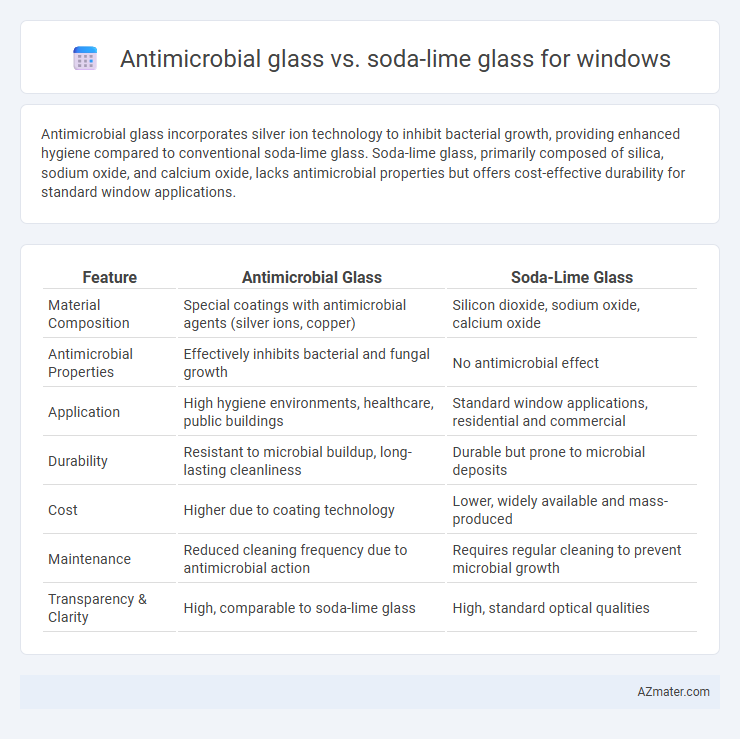Antimicrobial glass incorporates silver ion technology to inhibit bacterial growth, providing enhanced hygiene compared to conventional soda-lime glass. Soda-lime glass, primarily composed of silica, sodium oxide, and calcium oxide, lacks antimicrobial properties but offers cost-effective durability for standard window applications.
Table of Comparison
| Feature | Antimicrobial Glass | Soda-Lime Glass |
|---|---|---|
| Material Composition | Special coatings with antimicrobial agents (silver ions, copper) | Silicon dioxide, sodium oxide, calcium oxide |
| Antimicrobial Properties | Effectively inhibits bacterial and fungal growth | No antimicrobial effect |
| Application | High hygiene environments, healthcare, public buildings | Standard window applications, residential and commercial |
| Durability | Resistant to microbial buildup, long-lasting cleanliness | Durable but prone to microbial deposits |
| Cost | Higher due to coating technology | Lower, widely available and mass-produced |
| Maintenance | Reduced cleaning frequency due to antimicrobial action | Requires regular cleaning to prevent microbial growth |
| Transparency & Clarity | High, comparable to soda-lime glass | High, standard optical qualities |
Introduction to Antimicrobial and Soda-Lime Glass
Antimicrobial glass incorporates biocidal agents such as silver ions to inhibit the growth of bacteria, viruses, and fungi on its surface, promoting hygiene and reducing contamination risks in high-touch environments. Soda-lime glass, the most common type of glass used in windows, consists primarily of silica, soda, and lime, offering affordability, durability, and clarity but lacking inherent antimicrobial properties. Comparing these materials, antimicrobial glass provides enhanced sanitation benefits without compromising the structural and optical qualities typical of soda-lime glass.
Composition Differences: Antimicrobial vs Soda-Lime Glass
Antimicrobial glass incorporates silver or copper ions within its composition to inhibit bacterial growth, whereas soda-lime glass primarily consists of silica, sodium oxide, and calcium oxide without antimicrobial additives. The inclusion of metal ions in antimicrobial glass disrupts microbial cell function, providing continuous self-sterilizing properties not found in standard soda-lime glass. This compositional difference enhances antimicrobial glass's suitability for environments requiring higher hygiene standards, such as healthcare facilities and public spaces.
How Antimicrobial Glass Works
Antimicrobial glass incorporates a special coating infused with silver ions that disrupt bacterial cell membranes and inhibit microbial growth on the surface. This technology reduces the risk of pathogen transmission on windows commonly touched in public and healthcare settings. In contrast, soda-lime glass lacks these antimicrobial properties, making it less effective at preventing the proliferation of harmful microorganisms.
Benefits of Antimicrobial Glass for Windows
Antimicrobial glass for windows provides superior protection against bacteria, viruses, and mold growth compared to traditional soda-lime glass, enhancing hygiene in residential and commercial spaces. Its innovative coating maintains clarity while actively reducing microbial contamination, contributing to healthier indoor environments. This glass also offers increased durability and eases maintenance by preventing surface degradation caused by microbial activity.
Strength and Durability Comparison
Antimicrobial glass offers enhanced strength and durability compared to standard soda-lime glass, featuring higher resistance to scratches, impact, and environmental wear due to its specialized surface coatings. Soda-lime glass, while widely used and cost-effective, tends to be more susceptible to surface damage and deterioration over time under harsh conditions. The antimicrobial properties also contribute to longer-lasting clarity and reduced microbial degradation, enhancing the overall lifespan and performance of windows in both residential and commercial settings.
Impact on Indoor Air Quality
Antimicrobial glass significantly enhances indoor air quality by inhibiting the growth of bacteria, mold, and fungi on window surfaces, reducing airborne contaminants and allergens. In contrast, soda-lime glass lacks these antimicrobial properties, allowing microbial accumulation that can deteriorate air quality over time. Choosing antimicrobial glass for windows helps maintain a healthier indoor environment by minimizing biofilm formation and improving overall air hygiene.
Maintenance and Cleaning Requirements
Antimicrobial glass features a specialized coating that inhibits bacterial growth, reducing the frequency of deep cleaning and minimizing the use of harsh chemicals compared to standard soda-lime glass. Soda-lime glass, prevalent in most windows, often requires regular cleaning with conventional detergents to prevent smudges and microbial buildup, leading to higher maintenance efforts. The antimicrobial properties of coated glass enhance hygiene and longevity by maintaining surface clarity and reducing residue accumulation, making it a more cost-effective solution for long-term window maintenance.
Cost Analysis: Antimicrobial vs Soda-Lime Glass
Antimicrobial glass typically costs 20-30% more than standard soda-lime glass due to integrated coatings or additives that inhibit microbial growth, enhancing hygiene in medical or high-traffic environments. Soda-lime glass remains the most cost-effective option for general window applications, offering durability and clarity at a lower price point. Long-term savings with antimicrobial glass may offset initial expenses by reducing cleaning frequency and extending surface lifespan in contamination-prone areas.
Applications in Residential and Commercial Settings
Antimicrobial glass offers superior protection against bacteria and viruses, making it ideal for residential settings such as kitchens and bathrooms where hygiene is critical. In commercial environments like hospitals, offices, and retail spaces, antimicrobial glass enhances safety by reducing surface contamination and promoting healthier indoor air quality. Soda-lime glass remains a cost-effective option primarily suited for general window applications without specific antimicrobial needs in less sensitive environments.
Future Trends in Window Glass Technology
Antimicrobial glass integrates silver ions or copper particles to inhibit microbial growth, offering enhanced hygiene for window applications compared to traditional soda-lime glass, which lacks such properties. Future trends indicate a rise in demand for multifunctional window glass that combines antimicrobial features with smart technologies like self-cleaning and energy efficiency, driving innovation beyond conventional soda-lime formulations. Advanced manufacturing techniques and nanocoatings are expected to optimize the durability and performance of antimicrobial glass, positioning it as a sustainable alternative in next-generation architectural solutions.

Infographic: Antimicrobial glass vs Soda-lime glass for Window
 azmater.com
azmater.com